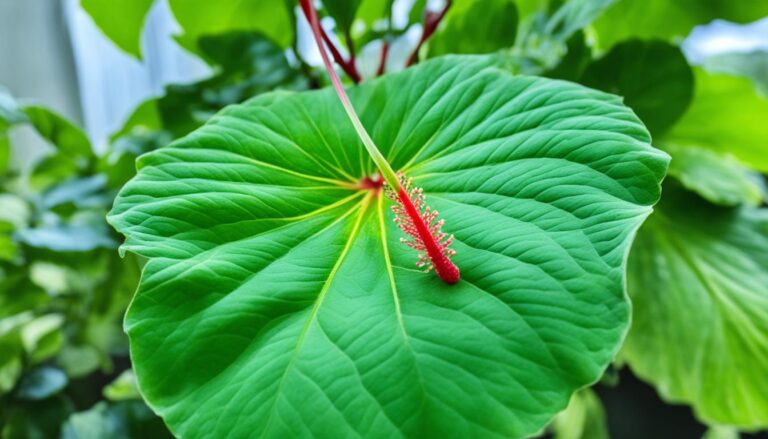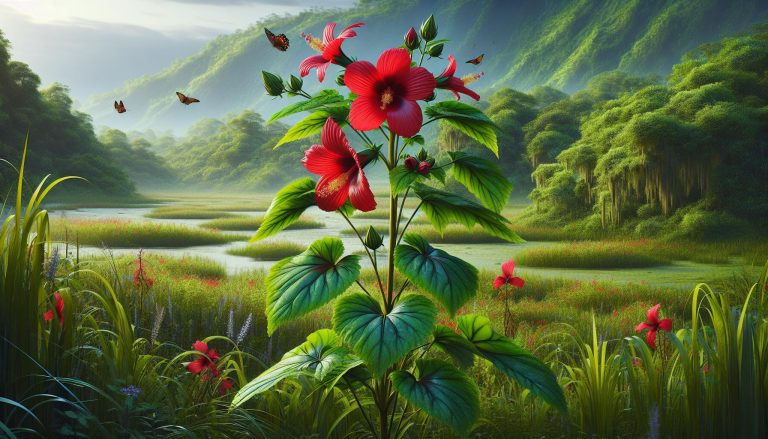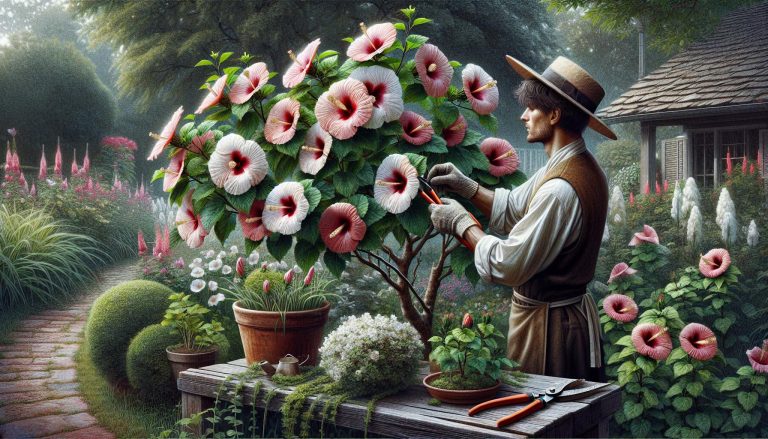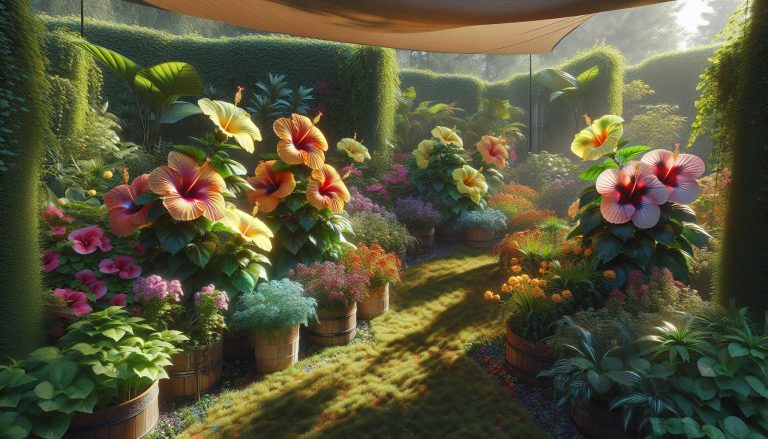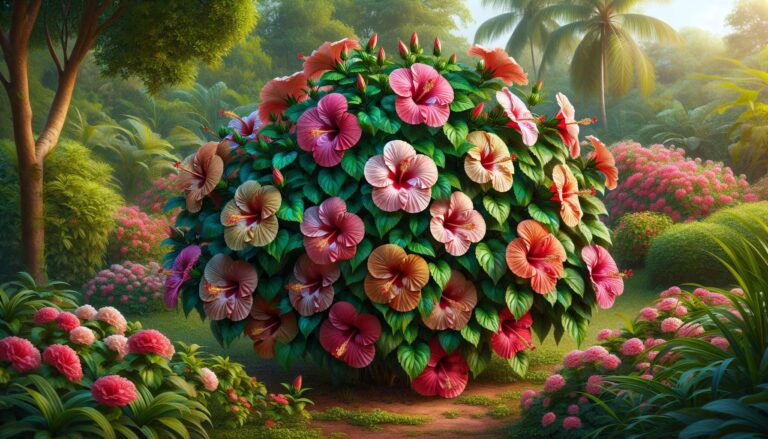Yellow Hibiscus: Hawaii State Flower Explained
Imagine yourself strolling along the picturesque shores of Hawaii, the warm sun kissing your skin and the gentle ocean breeze tousling your hair. As you explore the vibrant landscape, you can’t help but be captivated by the abundance of colorful flowers that adorn the islands. Among these, one flower stands out, its radiant yellow petals gleaming like drops of sunshine. This flower is none other than the yellow hibiscus, the official state flower of Hawaii.
The yellow hibiscus, scientifically known as Hibiscus brackenridgei or Maʻo-hau-hele, holds great cultural and symbolic significance in Hawaiian traditions. Its beauty, vibrancy, and unique characteristics make it a treasured emblem of the islands. Let’s explore the fascinating history, distinguishing features, and cultural importance of the yellow hibiscus as we delve into the enchanting world of Hawaii’s state flower.
Key Takeaways:
- The yellow hibiscus, also known as Hibiscus brackenridgei, is the official state flower of Hawaii.
- It holds cultural and symbolic significance, representing beauty, vibrancy, and the spirit of the islands.
- The yellow hibiscus is native to Hawaii and is found growing on all the main islands.
- Each Hawaiian island also has its own designated official flower or lei material.
- The yellow hibiscus is not only visually appealing but also versatile in its culinary uses and decorative purposes.
History of the Hawaii State Flower
The yellow hibiscus has a rich history in Hawaiian culture, predating the statehood of Hawaii. This vibrant flower was first recognized as a territorial emblem in the 1920s due to its exquisite beauty and widespread presence throughout the islands. The adoption of the yellow hibiscus as a territorial emblem symbolized the deep appreciation and reverence that Hawaiians held for this blooming wonder.
When Hawaii achieved statehood in 1959, it was only natural for the yellow hibiscus to be designated as the official state flower. With its long-standing cultural significance and iconic status, the yellow hibiscus became a fitting representation of the unique spirit and natural beauty of Hawaii.
The adoption of the yellow hibiscus as the state flower marked a significant moment in Hawaii’s history, solidifying the flower’s place as an enduring symbol of the islands from that point forward.
The Unique Yellow Hibiscus
The yellow hibiscus, also known as Hibiscus brackenridgei, stands out with its distinguishing features and traits. This native Hawaiian flower showcases large flowers, typically measuring 4 to 6 inches in diameter, making it an eye-catching addition to the tropical landscape.
The petals of the yellow hibiscus are a vibrant yellow color, often with a maroon center, creating a striking contrast that amplifies its beauty. These flowers can be found singly or in small clusters at the ends of the branches, adding a touch of elegance to the overall appearance of the plant.
One of the distinguishing characteristics of the yellow hibiscus is its staminal column, the central reproductive structure. In this particular variety, the staminal column is also yellow, complementing the color scheme of the flower and further emphasizing its unique nature.
Distinctive Features of the Yellow Hibiscus:
- Large flowers, measuring 4 to 6 inches in diameter
- Yellow petals, often with a maroon center
- Singly or clustered flowers at the ends of branches
- Yellow staminal column, the central reproductive structure
The yellow hibiscus, with its remarkable characteristics, adds a touch of vibrancy and allure to the Hawaiian landscape. Its unique traits make it a beloved symbol of Hawaii and a testament to the extraordinary beauty found in nature.
Symbolic and Cultural Significance
The yellow hibiscus holds great cultural and symbolic significance in Hawaii. It represents beauty, vibrancy, and the spirit of the islands. The flower’s bright yellow color is associated with joy and happiness in Hawaiian culture.
Throughout Hawaiian history, the yellow hibiscus has played an important role in ceremonies, festivals, and daily life. It is often used to create stunning leis, which are floral garlands worn as a symbol of welcome, affection, and honor. The vibrant yellow petals add a touch of natural beauty to these traditional Hawaiian adornments.
Not only is the yellow hibiscus visually striking, but it is also rich in cultural meaning. It embodies the essence of Hawaii’s tropical paradise and is regarded as a symbol of the islands’ unique heritage. The hibiscus is a source of natural inspiration for local artists, who frequently incorporate its image into their artwork, showcasing its connection to Hawaiian identity and history.
Yellow Hibiscus in Hawaiian Traditions
Hawaiian traditions and customs are deeply rooted in nature, and the yellow hibiscus holds a special place in these practices. Its vibrant blooms are used to celebrate milestones and special occasions, such as weddings and graduations. The flower’s radiant yellow color is believed to bring good luck and positive energy to those who wear or receive it.
The haʻa, or hula, the traditional Hawaiian dance, is often performed with yellow hibiscus flowers incorporated into the dancers’ costumes. The graceful movements and vibrant colors of the hibiscus create a visually captivating spectacle that embodies the beauty and spirit of Hawaii.
Hibiscus as a Lei Flower
Leis hold significant cultural importance in Hawaiian traditions, serving as a symbol of love, respect, and hospitality. The yellow hibiscus is a popular choice for creating leis due to its vibrant color and lush petals. The act of giving and receiving a hibiscus lei signifies a warm welcome and a gesture of friendship or affection.
Wearing a yellow hibiscus lei is not only a fashion statement but also a way to connect with the traditions and customs of the Hawaiian people. It is a tribute to the cultural diversity and spirit of Aloha that defines the islands.
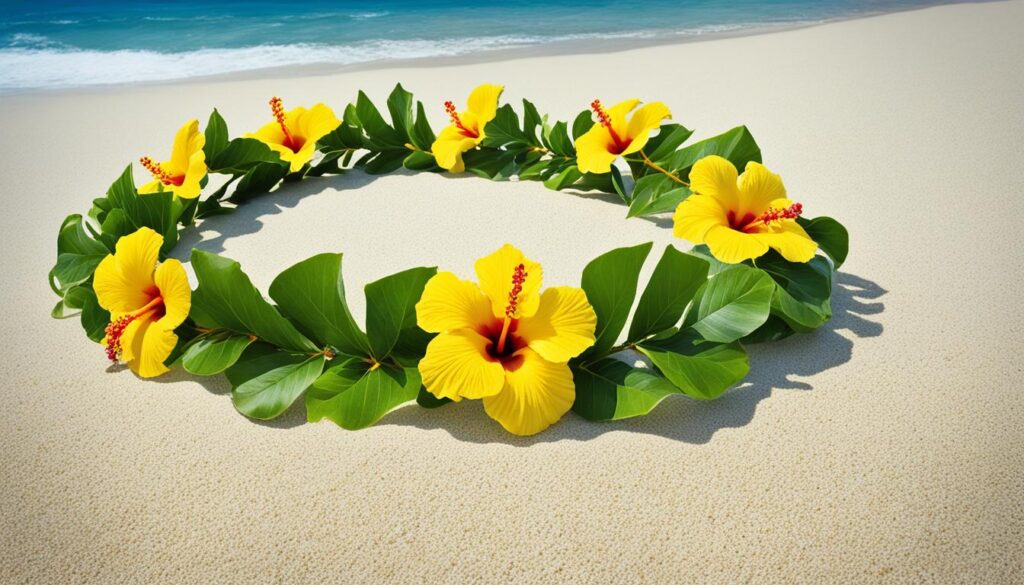
Other State Flowers of Hawaii
While the yellow hibiscus is the official state flower of Hawaii, each of the Hawaiian islands has its own designated official flower or lei material. These island-specific flowers add to the rich floral diversity of the archipelago, showcasing the unique natural beauty of each region.
Hawaii Island – ʻŌhi‘a Lehua
The official flower of Hawaii Island, also known as the Big Island, is the ʻŌhi‘a Lehua. This vibrant red blossom is a symbol of the island’s majesty and resilience. The ʻŌhi‘a Lehua is sacred in Hawaiian culture, representing love, devotion, and new beginnings.
Maui – Lokelani (Pink Damask Rose)
Maui, known for its stunning landscapes and romantic charm, has adopted the Lokelani as its official flower. The Lokelani, also known as the Pink Damask Rose, is a delicate and fragrant bloom. Its pink petals are reminiscent of the picturesque sunsets that grace the shores of the island.
O’ahu – Ilima
O’ahu, the bustling hub of Hawaii, has chosen the Ilima as its official flower. The Ilima is a small, golden-yellow flower that grows abundantly across the island. This cheerful blossom represents the island’s warmth, hospitality, and spirit of aloha.
Kaua’i – Mokihana
Kaua’i, often referred to as the Garden Isle, has selected the Mokihana as its official lei material. The Mokihana is a unique and fragrant green berry-like fruit that grows exclusively on the island. Its distinctive scent and vibrant color make it a cherished symbol of Kaua’i.
Moloka’i – White Kukui Blossom
Moloka’i, the island of peace and tranquility, honors its natural beauty with the White Kukui Blossom as its official flower. These white flowers, accompanied by the iconic kukui nuts, carry a sense of purity and enlightenment, capturing the essence of Moloka’i’s serene landscapes.
Lana’i – Kauna’oa (Yellow Beach Morning Glory)
Lana’i, known for its pristine beaches and untouched landscapes, identifies with the Kauna’oa, or Yellow Beach Morning Glory. This vibrant yellow flower is often found along the island’s stunning shoreline, bringing a touch of sunshine and beauty to Lana’i.
Ni’ihau – Pūpū Shell
Ni’ihau, the secluded “Forbidden Island,” embraces the unique beauty of the Pūpū Shell as its island-specific symbol. These small white shells, found abundantly on the island’s coastline, are revered for their rarity and elegance, reflecting the pristine nature of Ni’ihau.
Kaho’olawe – Hinahina (Beach Heliotrope)
Kaho’olawe, historically a sacred island, is represented by the Hinahina, also known as the Beach Heliotrope. This resilient coastal plant withstands the harsh conditions of the island, serving as a reminder of Kaho’olawe’s perseverance and the ongoing efforts to restore its natural beauty. The Hinahina is characterized by its silvery leaves and delicate lavender or white flowers.
| Island | Official Flower |
|---|---|
| Hawaii Island (Big Island) | ʻŌhi‘a Lehua |
| Maui | Lokelani (Pink Damask Rose) |
| O’ahu | Ilima |
| Kaua’i | Mokihana |
| Moloka’i | White Kukui Blossom |
| Lana’i | Kauna’oa (Yellow Beach Morning Glory) |
| Ni’ihau | Pūpū Shell |
| Kaho’olawe | Hinahina (Beach Heliotrope) |
These island-specific flowers and lei materials are cherished by the local communities and reflect the distinctiveness of each Hawaiian island. They serve as reminders of the abundant natural beauty and cultural diversity that make Hawaii such a special place.
Versatility of the Yellow Hibiscus
The yellow hibiscus is a remarkable flower that offers more than just visual appeal. With its vibrant and captivating beauty, it is no surprise that this versatile plant has found its way into various culinary creations, health remedies, and as a popular decorative element.
Culinary Uses of Hibiscus
The flowers of the yellow hibiscus are not only pleasing to the eyes but also a treat for the taste buds. They can be candied or dried and used as a delightful addition to pastries, cakes, and desserts. These edible flowers bring a unique touch of elegance to culinary creations, elevating both the flavor and visual appeal of dishes.
Moreover, hibiscus is often used to create flavorful teas and syrups, which are known for their distinct and refreshing taste. These beverages, commonly enjoyed hot or cold, offer a burst of flavor that is both soothing and invigorating. Hibiscus tea is particularly famous for its tart, cranberry-like taste, making it a popular choice for those seeking a caffeine-free alternative to traditional teas.
Hibiscus Health Benefits
In addition to its culinary applications, the yellow hibiscus also offers potential health benefits. Rich in vitamin C, hibiscus may help boost the immune system and promote overall well-being. Studies have shown that hibiscus tea may potentially aid in lowering blood pressure and supporting heart health. Its natural antioxidants contribute to reducing oxidative stress and inflammation in the body, supporting a healthy lifestyle.
Hibiscus as a Decorative Plant
The yellow hibiscus is not only cherished for its culinary and health benefits but is also a beloved plant for its decorative qualities. With its vibrant yellow petals and striking appearance, it attracts butterflies and bees, adding a touch of natural beauty to gardens, landscapes, and indoor spaces. Whether planted in flower beds, used as potted plants, or showcased in floral arrangements, the yellow hibiscus brings a burst of color and life wherever it thrives.
Culinary Uses of Yellow Hibiscus
| Application | Description |
|---|---|
| Candied Flowers | Delightful addition to pastries, cakes, and desserts |
| Dried Flowers | Elevates the flavor and visual appeal of dishes |
| Hibiscus Tea | Refreshing beverage with a tart, cranberry-like taste |
| Hibiscus Syrup | Sweet and tangy addition to cocktails, beverages, and desserts |
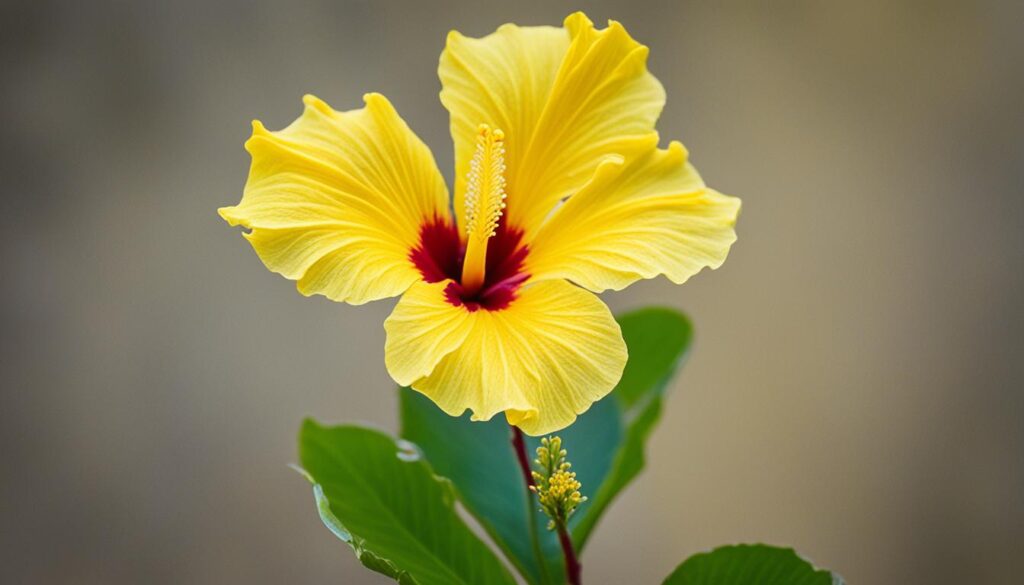
Yellow Hibiscus and Hawaiian Culture
The yellow hibiscus holds a special place in Hawaiian culture and traditions. Known for its vibrant yellow color and mesmerizing beauty, the yellow hibiscus is often used in the making of leis, which are floral garlands worn as a symbol of welcome, affection, and honor.
Leis are an integral part of Hawaiian customs and celebrations, representing the spirit of aloha and the warm hospitality of the islands. The yellow hibiscus adds an extra touch of beauty and cultural significance to these garlands, making them even more special.
Hawaiian leis, adorned with the vibrant yellow hibiscus, are given in various contexts, including weddings, graduations, and other joyous occasions. They are also presented as a gesture of respect, affection, or gratitude. The hibiscus lei is considered a treasured gift, symbolizing friendship, love, and the vibrant essence of Hawaii.
With its bright yellow petals and captivating beauty, the yellow hibiscus exemplifies the rich tapestry of Hawaiian traditions and the deep connection between nature and culture.
Native Species Preservation
Conservation of the yellow hibiscus and other native Hawaiian plants is a critical priority due to their endangered status. Efforts are underway to protect and restore the natural habitats of these plants, safeguarding their future. Dedicated organizations and individuals collaborate to raise awareness and promote the preservation of these precious native species.
The conservation of yellow hibiscus and other indigenous plants serves a vital purpose in maintaining the delicate balance of Hawaii’s unique ecosystem. By preserving these plants, we not only protect their inherent beauty and cultural significance but also preserve the biodiversity upon which countless other species depend.
Conservation Efforts
Conservation efforts for the yellow hibiscus and other native Hawaiian plants involve a comprehensive approach that includes habitat restoration, propagation programs, and public education initiatives. These actions aim to reverse the decline of these species and ensure their long-term survival.
Restoration projects focus on creating suitable environments for the plants to thrive. This involves removing invasive species, replanting native vegetation, and implementing sustainable land management practices. These efforts not only benefit the yellow hibiscus but also contribute to the overall health and resilience of Hawaii’s ecosystems.
Propagation programs play a crucial role in increasing the population of endangered native plants. Through careful cultivation and breeding, experts aim to increase the numbers of these species and reintroduce them into their natural habitats. This helps to restore ecological balance and enhance the chances of long-term survival for these plants.
Public education and awareness campaigns are essential for fostering a sense of stewardship and inspiring action among the local community and visitors to Hawaii. By educating people about the value of native Hawaiian plants and the importance of conservation efforts, we can work together to protect and preserve these natural treasures.
Collaborative Action
Conservation of native Hawaiian plants requires collaboration between government agencies, conservation organizations, local communities, and individuals. By joining forces, we can pool resources, knowledge, and expertise to achieve meaningful results.
Government agencies play a crucial role in establishing and enforcing regulations that protect endangered species and their habitats. They provide funding and support for conservation programs and work to ensure the continued protection of these plants.
Conservation organizations, such as the Hawaiian Conservation Alliance and the Hawaii Invasive Species Council, work tirelessly to promote the preservation of native Hawaiian plants. They conduct research, coordinate conservation efforts, and engage in public outreach to raise awareness and mobilize support.
Local communities have a vital role to play in conservation efforts. By actively participating in habitat restoration projects, supporting native plant nurseries, and embracing sustainable practices, communities can contribute to the protection of the yellow hibiscus and other native species.
Individual actions also make a difference. By respecting protected areas, avoiding the introduction of invasive species, and learning about Hawaii’s unique ecosystems, individuals can contribute to the conservation of native Hawaiian plants.
The Importance of Preservation
Preserving the yellow hibiscus and other native Hawaiian plants is not just about saving a particular species; it is about protecting the rich cultural heritage and ecological diversity of Hawaii. These plants are deeply intertwined with the history, traditions, and identity of the Hawaiian people.
By conserving and restoring the natural habitats of these plants, we ensure that future generations can continue to experience the beauty and wonder of Hawaii’s native flora. The yellow hibiscus and other indigenous species are a precious part of our natural heritage, deserving of our protection and admiration.
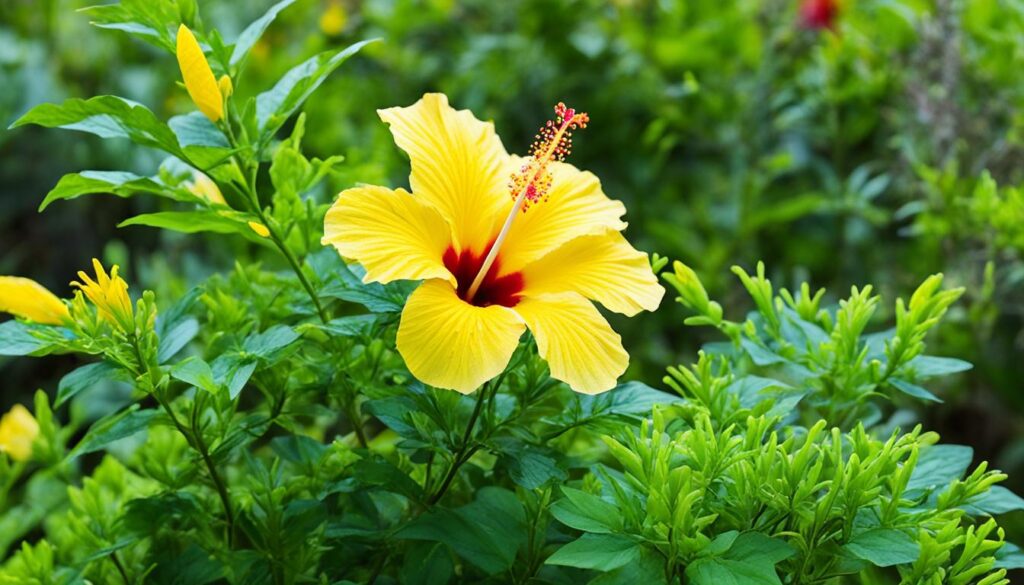
| Conservation Efforts | Collaborative Action |
|---|---|
| Restoration projects | Government agencies |
| Propagation programs | Conservation organizations |
| Public education initiatives | Local communities |
| Individual actions |
Hibiscus Taxonomy
The yellow hibiscus, like other hibiscus varieties, belongs to the Hibiscus genus. This genus encompasses a wide range of species and hybrids that are known for their vibrant flowers and ornamental value. One well-known species within this genus is the Hibiscus rosa-sinensis, commonly referred to as the common hibiscus.
Hibiscus rosa-sinensis is a tropical plant that thrives in warm climates and is widely cultivated for its beauty. It is characterized by its large, showy flowers in various hues, including shades of red, pink, orange, and yellow. This species has a long history of cultivation and has been enjoyed as an ornamental plant in gardens and landscapes around the world.
Hibiscus Classification
The classification of hibiscus plants is based on their morphology, genetics, and other botanical characteristics. It involves categorizing them into different species, subspecies, and varieties. Within the Hibiscus genus, there are several notable classifications, including:
- Hibiscus rosa-sinensis: Commonly known as the common hibiscus or Chinese hibiscus, this species encompasses numerous cultivars with diverse flower colors and patterns. It is widely used in landscaping and horticulture.
- Hibiscus acetosella: Also known as African rosemallow, this species is prized for its striking red foliage and vibrant flowers. It is primarily grown as an annual or perennial ornamental plant.
- Hibiscus syriacus: Popularly known as the rose of Sharon, this species is native to East Asia and is celebrated for its large, colorful flowers. It is commonly cultivated as a flowering shrub.
- Hibiscus sabdariffa: This species, commonly known as roselle, is cultivated for its edible calyces, which are used to make teas, jams, and other culinary creations. It is also valued for its medicinal properties.
The diverse classifications within the Hibiscus genus showcase the wide range of species and cultivars available to gardeners and enthusiasts. Whether for their beauty, culinary uses, or medicinal benefits, hibiscus plants continue to captivate and delight people around the world.
Appreciating the Yellow Hibiscus
The yellow hibiscus holds deep cultural significance in Hawaii and is cherished as a symbol of the islands’ natural beauty. This beloved flower is celebrated and appreciated in various art forms and cultural expressions, showcasing its importance in Hawaiian art and traditions.
Throughout the islands, you can find an abundance of paintings, photographs, and other artworks featuring the yellow hibiscus. These artistic representations capture the vibrant colors and intricate details of the flower, allowing viewers to appreciate its beauty and cultural significance.
The yellow hibiscus’s presence in Hawaiian art reflects its deep-rooted connection to the islands and its people. It serves as a reminder of Hawaii’s lush landscapes, tropical climate, and the spirit of aloha. Artists often incorporate the hibiscus into their works as a way to honor and pay homage to the indigenous flora of Hawaii.
Whether displayed in galleries, adorning walls, or featured in traditional crafts, the yellow hibiscus continues to inspire and captivate with its striking presence. This iconic flower not only represents the beauty of Hawaii but also serves as a symbol of resilience and the preservation of Hawaiian culture.
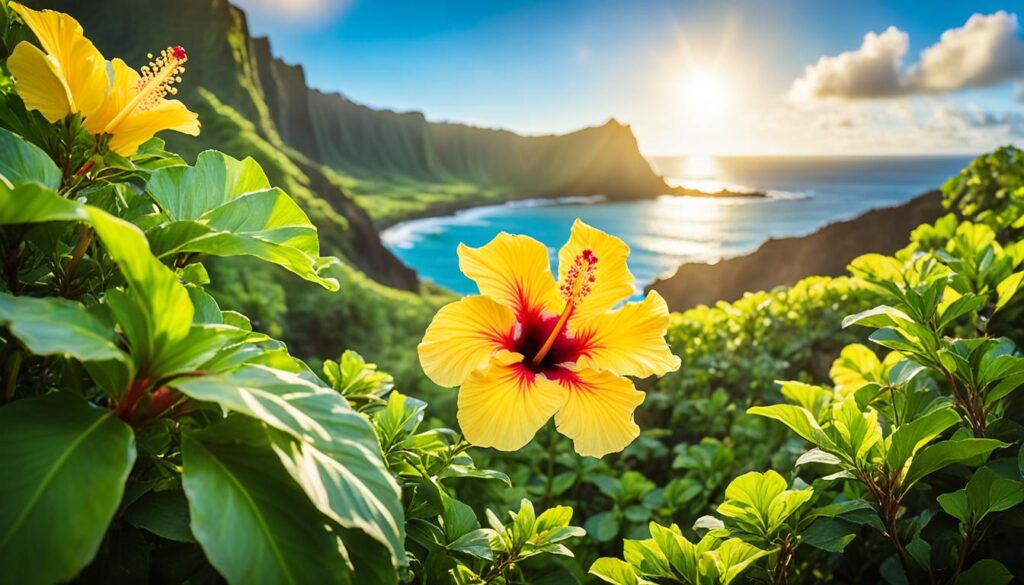
In Hawaiian culture, art plays a crucial role in storytelling and preserving traditions. The inclusion of the yellow hibiscus in various art forms serves as a visual narrative, communicating the cultural significance and appreciation for this beloved flower.
As you explore the vibrant art scene in Hawaii, allow yourself to immerse in the beauty and symbolism of the yellow hibiscus. Embrace the spirit of hibiscus appreciation and gain a deeper understanding of its role as a representation of Hawaii’s natural wonders.
The Beauty of Hawaii’s State Flower
The yellow hibiscus is a true natural wonder, captivating all who have the pleasure of witnessing its radiant beauty. With its vibrant yellow color and stunning appearance, the yellow hibiscus stands out as a symbol of tropical charm. Whether you’re a local or a visitor, the allure of the hibiscus’s beauty is impossible to resist, adding an extra touch of enchantment to Hawaii’s breathtaking landscape.
What makes the yellow hibiscus truly remarkable are its large flowers and distinct features. Each delicate petal, bathed in striking yellow hues, is a testament to the flower’s elegance. The flowers themselves can be as large as 4 to 6 inches in diameter, demanding attention wherever they bloom. It is no wonder that this tropical flower is held in such high regard.
Not only is the yellow hibiscus visually stunning, but it also carries deep cultural significance. In Hawaiian culture, the hibiscus is cherished for its beauty and is often used for various ceremonial purposes. From leis to traditional adornments, the hibiscus adds an unmistakable touch of elegance to these treasured traditions.
As you explore the vibrant Hawaiian islands, you’ll find the yellow hibiscus enriching the surroundings with its vibrant petals. Its natural allure is a testament to the tropical paradise of Hawaii, leaving an indelible impression on all who encounter it. Embrace the beauty of the yellow hibiscus and immerse yourself in Hawaii’s enchanting floral landscape.
Conclusion
The yellow hibiscus, the official state flower of Hawaii, holds a significant place in Hawaiian culture. Its vibrant beauty, cultural symbolism, and versatile uses make it an important symbol of the islands. The preservation and appreciation of the yellow hibiscus contribute to the celebration of Hawaii’s natural beauty and cultural heritage.
With its large flowers, distinct features, and yellow petals, the yellow hibiscus stands out as a tropical flower that represents joy and happiness in Hawaiian culture. It is often used in ceremonies, leis, and other cultural traditions, adding to its cultural importance.
The yellow hibiscus’s versatility extends beyond its ornamental value. The flowers are edible and can be used to make teas and syrups with unique flavors. Additionally, hibiscus is known for its potential health benefits, such as lowering blood pressure. The plant’s decorative purpose, attracting butterflies and bees, adds to its appeal.
Preserving the yellow hibiscus and other native Hawaiian plants is crucial due to their endangered status. Conservation efforts aim to protect and restore the natural habitats of these plants, with organizations and individuals working together to raise awareness and promote the conservation of these indigenous species.


